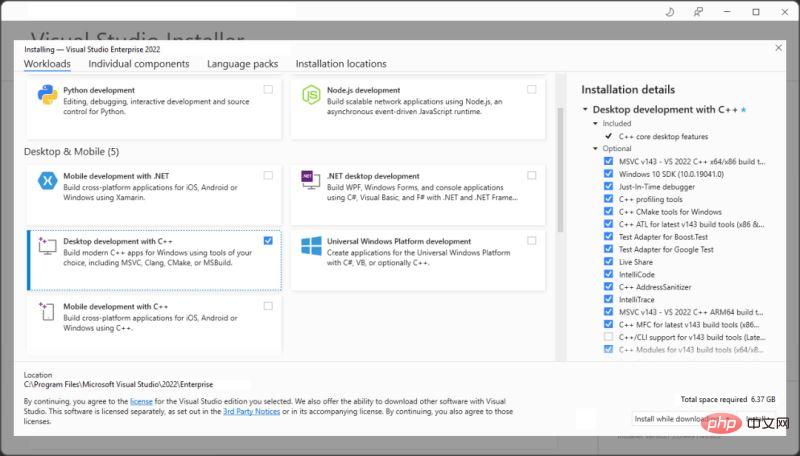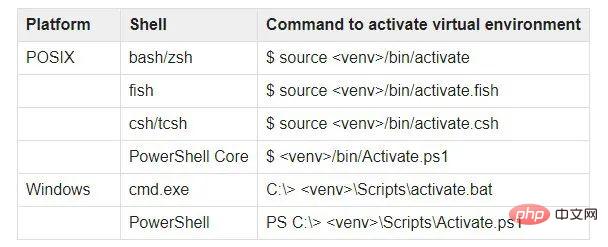 Backend Development
Backend Development
 Python Tutorial
Python Tutorial
 Methods and steps for implementing face recognition using Python
Methods and steps for implementing face recognition using Python
Methods and steps for implementing face recognition using Python
For the development environment, we will use Visual Studio Community Edition.
If it is not installed on your computer yet, you can download it from here. and install desktop development using C.

Now that we have Visual Studio for desktop development in C, we can start our project.
Use Visual Studio to open a new directory and create a new python environment. We will use venv. Open your integrated terminal and write python -m venv venv. Then activate the environment by typing venv/bin/Activate.ps1. This is for PowerShell.
If you are using any other terminal you can find the full list here

Now that we have finished creating the virtual environment, let’s start extracting Our dependencies. For this we will need opencv and face_recognition. Use pip within your terminal.
pip install opencv-python face_recognition
Face Recognition is a library that uses the state-of-the-art dlib library. We're ready to write some code and recognize some faces.
Create a new python file, we will call the file missingPerson.py, assuming we will use our application to match missing persons. Import our dependencies and write our first few lines.
import cv2 import numpy as np import face_recognition import os from face_recognition.api import face_distance
Assuming all of our photos are stored in our server storage, we need to first pull the images of all the people into our application and read those images.
path = 'MissingPersons'
images = []
missingPersons = []
missingPersonsList = os.listdir(path)
for missingPerson in missingPersonsList :
curImg = cv2.imread(f'{path}/{missingPerson}')
images.append(curImg)
missingPersons.append(os.path.splitext(missingPerson)[0])
print(missingPersons)In this section we will use opencv to read all images of missing persons and append them to our missingPerson list.
After we read all the missing face images from storage, we need to find the face encoding so that we can use the CNN face detector to create a 2D array of face bounding boxes in the image.
def findEncodings(images):
encodeList = []
for img in images:
img = cv2.cvtColor(img, cv2.COLOR_BGR2RGB)
encode = face_recognition.face_encodings(img)[0]
encodeList.append(encode)
print(encodeList)
return encodeList
encodeListKnown = findEncodings(images)
print('Encoding Complete')We store the two-dimensional array into a list of known face codes. This will take several minutes.
Now that we have the facial codes for all the missing people, all we have to do now is match them to our reporter image. face_recognition is very convenient to use.
def findMissingPerson(encodeListKnown, reportedPerson='found1.jpg'):
person = face_recognition.load_image_file(f'ReportedPersons/{reportedPerson}]')
person = cv2.cvtColor(person,cv2.COLOR_BGR2RGB)
try:
encodePerson = face_recognition.face_encodings(person)[0]
comparedFace = face_recognition.compare_faces(encodeListKnown,encodePerson)
faceDis = face_recognition.face_distance(encodeListKnown,encodePerson)
matchIndex = np.argmin(faceDis)
if comparedFace[matchIndex]:
name = missingPersons[matchIndex].upper()
print(name)
return name
else:
print('Not Found')
return False
except IndexError as e:
print(e)
return eFirst we need to load the image file of the reporter and encode their face. All that remains is to compare the reported face encodings with what we already know about face encodings. Then a simple logic matches their index and returns if the person is found in our missingPersons list.
This kind of facial recognition is not only used to find missing people. It detects and recognizes faces and can operate as needed.
The above is the detailed content of Methods and steps for implementing face recognition using Python. For more information, please follow other related articles on the PHP Chinese website!

Hot AI Tools

Undresser.AI Undress
AI-powered app for creating realistic nude photos

AI Clothes Remover
Online AI tool for removing clothes from photos.

Undress AI Tool
Undress images for free

Clothoff.io
AI clothes remover

Video Face Swap
Swap faces in any video effortlessly with our completely free AI face swap tool!

Hot Article

Hot Tools

Notepad++7.3.1
Easy-to-use and free code editor

SublimeText3 Chinese version
Chinese version, very easy to use

Zend Studio 13.0.1
Powerful PHP integrated development environment

Dreamweaver CS6
Visual web development tools

SublimeText3 Mac version
God-level code editing software (SublimeText3)

Hot Topics
 1662
1662
 14
14
 1419
1419
 52
52
 1313
1313
 25
25
 1262
1262
 29
29
 1235
1235
 24
24
 PHP and Python: Different Paradigms Explained
Apr 18, 2025 am 12:26 AM
PHP and Python: Different Paradigms Explained
Apr 18, 2025 am 12:26 AM
PHP is mainly procedural programming, but also supports object-oriented programming (OOP); Python supports a variety of paradigms, including OOP, functional and procedural programming. PHP is suitable for web development, and Python is suitable for a variety of applications such as data analysis and machine learning.
 Choosing Between PHP and Python: A Guide
Apr 18, 2025 am 12:24 AM
Choosing Between PHP and Python: A Guide
Apr 18, 2025 am 12:24 AM
PHP is suitable for web development and rapid prototyping, and Python is suitable for data science and machine learning. 1.PHP is used for dynamic web development, with simple syntax and suitable for rapid development. 2. Python has concise syntax, is suitable for multiple fields, and has a strong library ecosystem.
 PHP and Python: A Deep Dive into Their History
Apr 18, 2025 am 12:25 AM
PHP and Python: A Deep Dive into Their History
Apr 18, 2025 am 12:25 AM
PHP originated in 1994 and was developed by RasmusLerdorf. It was originally used to track website visitors and gradually evolved into a server-side scripting language and was widely used in web development. Python was developed by Guidovan Rossum in the late 1980s and was first released in 1991. It emphasizes code readability and simplicity, and is suitable for scientific computing, data analysis and other fields.
 Python vs. JavaScript: The Learning Curve and Ease of Use
Apr 16, 2025 am 12:12 AM
Python vs. JavaScript: The Learning Curve and Ease of Use
Apr 16, 2025 am 12:12 AM
Python is more suitable for beginners, with a smooth learning curve and concise syntax; JavaScript is suitable for front-end development, with a steep learning curve and flexible syntax. 1. Python syntax is intuitive and suitable for data science and back-end development. 2. JavaScript is flexible and widely used in front-end and server-side programming.
 How to run sublime code python
Apr 16, 2025 am 08:48 AM
How to run sublime code python
Apr 16, 2025 am 08:48 AM
To run Python code in Sublime Text, you need to install the Python plug-in first, then create a .py file and write the code, and finally press Ctrl B to run the code, and the output will be displayed in the console.
 Where to write code in vscode
Apr 15, 2025 pm 09:54 PM
Where to write code in vscode
Apr 15, 2025 pm 09:54 PM
Writing code in Visual Studio Code (VSCode) is simple and easy to use. Just install VSCode, create a project, select a language, create a file, write code, save and run it. The advantages of VSCode include cross-platform, free and open source, powerful features, rich extensions, and lightweight and fast.
 Can visual studio code be used in python
Apr 15, 2025 pm 08:18 PM
Can visual studio code be used in python
Apr 15, 2025 pm 08:18 PM
VS Code can be used to write Python and provides many features that make it an ideal tool for developing Python applications. It allows users to: install Python extensions to get functions such as code completion, syntax highlighting, and debugging. Use the debugger to track code step by step, find and fix errors. Integrate Git for version control. Use code formatting tools to maintain code consistency. Use the Linting tool to spot potential problems ahead of time.
 How to run python with notepad
Apr 16, 2025 pm 07:33 PM
How to run python with notepad
Apr 16, 2025 pm 07:33 PM
Running Python code in Notepad requires the Python executable and NppExec plug-in to be installed. After installing Python and adding PATH to it, configure the command "python" and the parameter "{CURRENT_DIRECTORY}{FILE_NAME}" in the NppExec plug-in to run Python code in Notepad through the shortcut key "F6".



